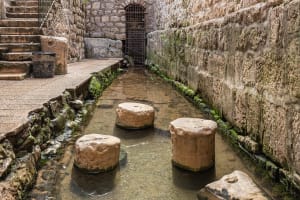Israeli archaeologists continue search for Pool of Siloam in ancient City of David

For nearly two decades, archaeologists working in the City of David, near the Old City of Jerusalem, have worked on identifying the exact location of the ancient Pool of Siloam. New findings have shed light on a couple of possibilities. In John 9, we read of the miraculous healing of a blind man in the Pool of Siloam. “After saying this, he spit on the ground, made some mud with the saliva, and put it on the man’s eyes. “Go,” he told him, “wash in the Pool of Siloam”. So the man went and washed, and came home seeing” (John 9:6-7).
"The word 'Siloam' is a Greek transliteration of the Hebrew word 'Shiloah,' which means 'sent,' as explained in the gospel.
Although John does not specify the location of the pool , we can identify it through at least two other sources. First, the “Pool of Siloam” is mentioned several times in the Old Testament, indicating its location in the lower valley beneath the City of David, where King Hezekiah redirected the water of the Gihon Spring through a tunnel. Second, the nearby Arab village called “Silwan” retains the Greek name for Siloam, further supporting the location.
Since excavations began in the City of David about 150 years ago, the Pool of Siloam has been identified as the narrow pool at the exit of Hezekiah’s Tunnel, where the water from the Gihon Spring flows . Visitors who have walked through the tunnel would end their tour at this small pool.
Twenty years ago, in 2002, while a tractor was working in the area, it struck some stones in the ground and had to stop. The Israeli archaeologists Ronny Reich and Eli Shukron started excavating the area and uncovered a monumental staircase that goes down from north to south into what seems like a huge pool.
The staircase was constructed in three sections, each with five steps. The northern side was fully uncovered, along with the beginning of the eastern and western sides. However, at this point, the archaeological work had to cease because the land belonged to the Greek Orthodox Patriarch, who had a private garden on that site and did not permit further excavation .
The discovery ignited the imagination of scholars. Many publications announced that the "real" Pool of Siloam had been rediscovered, while the "old" one at the end of Hezekiah’s Tunnel was considered a late Byzantine pool. Several posters featuring drawings reconstructing the pool’s original appearance were displayed at the site and in various books.
One question about the new finding remained unanswered: What was the purpose of the large pool? If it was merely a water reservoir for the city, what was the significance of the massive hewn steps surrounding it?
Many have suggested the pool was used as a ritual bath for the multitude that came to the Temple during pilgrimage feasts. However this idea seems unlikely: Ritual baths (mikvehs) required complete nudity, and there is no evidence of large public mikvehs like this elsewhere.
Everyone waited for the day when excavations would resume and the pool, in all its glory, would be revealed.
It took almost 20 years to settle the issues with the Greek Orthodox Patriarch and the excavation was renewed between 2023 and 2024.
Tractors came and unrooted the trees of the garden. Next, they dug all the dirt that filled the area. When they got to ancient layers, they moved to manual work. But the disappointment was enormous. As the digging progressed, the more clear it became that there were no steps on the opposite side of the pool. There was in fact no “other side.” The monumental staircase on the north side had some continuation on the east and west but did not continue to the south. It became evident that this could not be a pool.
Everyone wanted to hear how the archaeologists would explain the dilemma. In September 2024, during the latest research conference on the City of David, Nahshon Szanton presented a theory developed by his team.
He proposed a somewhat speculative idea. Comparing the staircases to similar constructions in the early Roman period, he suggests that the steps were not used for bathing in the water but rather were seats for people to sit on, watching down into a pool below. This is what is known in Roman culture as naumachia - a type of theater used for staging water shows as entertainment.
Like in a regular theater, where spectators watch plays with actors, in a naumachia, they watched reenactments of famous naval battles.
Naumachias were known throughout the Roman empire, but until now, there was no clear evidence that such structures existed in Judea.
So, if this is not the Pool of Siloam after all, then where is it? Szanton and his colleagues propose that the Pool of Siloam be brought back to its original identification at the exit of Hezekiah’s tunnel. We can be sure that the final word has not yet been spoken.
Excavations in the City of David always bring new surprises. What else lies buried beneath the dirt at this ancient and unique site waiting to be discovered?

Ran Silberman is a certified tour guide in Israel, with a background of many years in the Israeli Hi-Tech industry. He loves to guide visitors who believe in the God of Israel and want to follow His footsteps in the Land of the Bible. Ran also loves to teach about Israeli nature that is spoken of in the Bible.
You might also like to read this:















